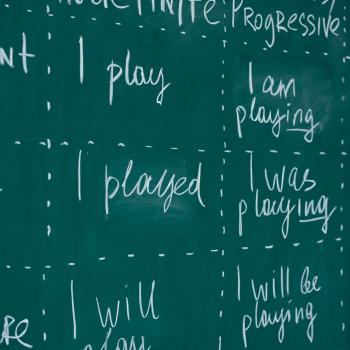Improve Comprehension: A Word Game Using Root Words and Affixes

- Preview |
- Standards |
- Resources & Preparation |
- Instructional Plan |
- Related Resources |
- Comments
Overview
Middle school students love friendly competition, and word games can be an ideal context to help them study the meaning, structure, and spelling of words. In this lesson, students practice analyzing word meanings by learning root words and affixes. They work in a variety of ways with a list of about 20 common but challenging words to learn the definition and spelling of each. Then they get in small groups to design and play the Make-a-Word card game, during which they must form complete words with three cards: a prefix, a root word, and a suffix.
Featured Resources
Make-a-Word Game Chart: This handy chart will help your students research and record the meaning of each prefix, root word, and suffix of the words listed.
From Theory to Practice
- Word-recognition skills must be developed to the point of fluency if comprehension benefits are to be maximized. In this way students can use their cognitive skills to focus on comprehension of the text.
- A first recommendation to educators who want to improve students' comprehension skills is to teach them to decode well.
- Experiments have shown that comprehension improves as a function of vocabulary instruction.
Common Core Standards
This resource has been aligned to the Common Core State Standards for states in which they have been adopted. If a state does not appear in the drop-down, CCSS alignments are forthcoming.
State Standards
This lesson has been aligned to standards in the following states. If a state does not appear in the drop-down, standard alignments are not currently available for that state.
NCTE/IRA National Standards for the English Language Arts
- 3. Students apply a wide range of strategies to comprehend, interpret, evaluate, and appreciate texts. They draw on their prior experience, their interactions with other readers and writers, their knowledge of word meaning and of other texts, their word identification strategies, and their understanding of textual features (e.g., sound-letter correspondence, sentence structure, context, graphics).
- 6. Students apply knowledge of language structure, language conventions (e.g., spelling and punctuation), media techniques, figurative language, and genre to create, critique, and discuss print and nonprint texts.
- 8. Students use a variety of technological and information resources (e.g., libraries, databases, computer networks, video) to gather and synthesize information and to create and communicate knowledge.
- 12. Students use spoken, written, and visual language to accomplish their own purposes (e.g., for learning, enjoyment, persuasion, and the exchange of information).
Materials and Technology
- Dictionaries
- 60 index cards for each group of three or four students
- Markers, pens, and pencils for each group
- Computers with Internet access
Printouts
Websites
Preparation
| 1. | If you do not have classroom computers with Internet access, reserve Session 1 in your school's computer lab. Note that you will want to have dictionaries available for students to use while working in the lab. |
| 2. |
Review the following websites to get an idea of how the concept of word parts is presented in different ways. Bookmark these websites on the computers students will be using. |
| 3. | Print and make copies of the following handouts for every student in your class: |
| 4. | Print and review the Affixes and Root Words: Teacher's Guide to use as a reference when reviewing students' work. |
| 5. | If students in your class have not worked with word parts before, prepare working definitions of prefix, root word, and suffix to share with them. You can use the definitions that appear at the top of the Prefix, Root Word, and Suffix Study Sheet. |
Student Objectives
Students will
- Learn how affixes and root words affect word meaning
- Develop an awareness of how to decipher word meaning by analyzing the affixes and root words and looking at context
- Synthesize what they have learned by constructing game cards that contain root words and affixes
- Work cooperatively in small groups to make and play a word card game
- Understand how this knowledge will help them to improve reading comprehension and spelling
Session 1
Immediately before this session, write the following word parts on the board in a haphazard way: trans, port, able, un, beat, able, re, consider, ation, de, grad, ation. They should be out of order, at different angles, and, if possible, in different colors. On another part of the board, make a chart with the following column titles: Complete Word, Prefix, Root Word, Suffix, and Meaning.
| 1. | Begin by asking students to look closely at the word parts on the board and to try to form complete words with them. After a few responses, explain the chart headings briefly if students are not familiar with the terms. Start filling in the chart on the board with student feedback, asking volunteers to say what they think the words mean. The completed chart might look something like this:
|
|||||||||||||||||||||||||
| 2. | Take students to the computer lab, if necessary, and have dictionaries available for them. Hand out the Make-a-Word Game Chart. Tell them that they will be making and playing a card game, but to do this they need to determine the meaning of each prefix, root word, and suffix and copy it onto the chart. The websites listed provide most meanings, with the exception of the root words that can act as words on their own. Ask students to identify these words (consider, complete, believe, activate, lax, act), and explain that they will need to look them up in the dictionary. |
|||||||||||||||||||||||||
| 3. | As students finish, give each of them a copy of the Prefix, Root Word, and Suffix Study Sheet and have them read the introduction and paragraph, underlining any words they think have prefixes or suffixes. Have them write the meaning of the words, without using the dictionary, below the paragraph. They should try using information from the Make-a-Word Game Chart to guess if they do not know the meanings of the words. |
|||||||||||||||||||||||||
| 4. | Pass out the Definition Study handout and tell students to match the words with their definitions, putting the corresponding letter next to the words. If class time is limited, this can be assigned as homework. |
Session 2
| 1. | Go over the Make-a-Word Game Chart and Definition Study handouts and read the correct answers while students make changes as necessary. Ask students to look at their charts and talk about how the definitions of the entire words relate to the definitions of the word parts. |
| 2. | Read "The Garbage Problem" paragraph (from the Prefix, Root Word, and Suffix Study Sheet) aloud to the class and ask if it makes more sense now that they have analyzed the difficult words. Have students discuss words that were hard for them. Tell them to pick the three hardest words, look them up in the dictionary, and write the definition next to their guess to see how close they were. |
| 3. | Ask students to talk about why knowing the meanings of parts of words might help them to improve reading comprehension and spelling. Encourage them to use examples from the chart to reflect on the fact that word parts can have the same spelling and meaning when used in different words. You want to make sure students understand that these affixes can be put together with root words like a puzzle to form new words. This means we can use logic and our knowledge of what the affixes and root words mean to decipher the meaning and spelling of new words. |
| 4. | Have students get into heterogeneous groups of three or four students, possibly mixing outgoing students with introverted students. Give each group the Make-a-Word Game Instructions and the 60 blank index cards. Have them keep their Make-a-Word Game Charts out as they will need them to make the game. Tell students to closely follow the instructions to make and play the game, and that they will earn a grade for this activity based on how well they work together as a group to carry out the instructions. |
Session 3
| 1. | Students should start or continue playing the card game. Groups may play more than one game if time permits. |
| 2. | Pass out the Make-a-Word Self-Evaluation and give students time to answer the questions. Then discuss their answers as a class. Encourage students to reflect on what they learned and its value in the larger context of their school work and how they might use this information in the future to improve their reading comprehension and spelling. Consider also how they learned together through a group activity. |
Extensions
- In the days that follow the card game, offer students extra points if they find one of the 20 words from the game in their reading or if they point it out when you use the word during class.
- Have students use the Stapleless Book to make a book depicting eight of the 20 words they created game cards for. Each page can include the complete word and its definition, the meaning of each word part, a sentence using the word, and a drawing to illustrate the sentence.
- Use the websites listed in the Web Resources to make additional sets of cards with root words and affixes. You might even sponsor a tournament in your class to see who can make the most words.
Student Assessment / Reflections
- Circulate around the classroom as students make and play the card game, taking notes on how groups are working together and making comments as needed. You may want to work individually with students who are struggling to form words.
- Have students turn in all work and review it to check for understanding. Give students a grade based on correct completion of the assignment and hand the work back to students so they can review it.
- Continue class discussions about root words and affixes as new vocabulary words are introduced throughout the year. Continue to monitor how well students understand the construction of words and how this affects their reading comprehension and spelling.
